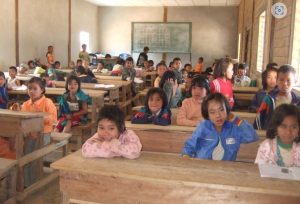Myanmar’s school system rises from the ashes
Amid the chaos and devastation of the civil war in Myanmar, an underground education system is emerging.
In displacement camps and small villages in areas beyond the brutal control of Myanmar’s military, children are returning to classrooms.
Around the town of Thatlang, in Chin State, which has largely been flattened by repeated government attacks, an education committee made up of striking civil servants and local volunteers is running 51 schools, attended by more than 7,000 students.
More than eight million school-aged youth in Myanmar have lost two years of formal education – first because of the to the COVID-19 pandemic and then because of the coup, which prompted mass boycotts of schools under the military administration.
 Although Myanmar remains in the throes of a civil war and a humanitarian crisis, ethnic revolutionary organisations and new independent administrative bodies are now operating extensive school systems across the country as they strive to ensure that children don’t miss out on even more of their education.
Although Myanmar remains in the throes of a civil war and a humanitarian crisis, ethnic revolutionary organisations and new independent administrative bodies are now operating extensive school systems across the country as they strive to ensure that children don’t miss out on even more of their education.
When government schools re-opened last June under the supervision of Myanmar’s military junta, only 10 percent of eligible students turned up.
A civil disobedience campaign, targeting the junta which seized power in February 2021, gained widespread popularity based around a slogan that railed against participating in a “military slave education”.
More than 100,000 teachers also went on strike.
Safety concerns also played a role in the low enrolments: As of last March, military forces had occupied more than 60 education facilities, according to UNICEF and the NGO Save the Children.
Save the Children also reported more than 100 violent attacks on schools.
Two years on, as resistance groups have gained ground, longstanding ethnic revolutionary organisations have expanded existing school systems in their territories.
And teams of striking civil servants, politicians, civil society groups and local volunteers have established grass roots school systems in contested areas and areas where armed resistance groups now claim territorial control.
Communities in Chin State, for example, were among the first to establish new schools outside of the military administration with more than 170 schools now running in southern Chin State.
Teachers in the new schools in Chin are using a hybrid curriculum that incorporates elements of the former government curriculum and lessons in students’ ethnic languages.
An education system run in the Karenni State under an ethnic revolutionary organisation has expanded from 45 to 129 schools over the past year and is now serving more than 12,000 students.
But the new schools are facing huge challenges.
There are internally displaced persons (IDPs) staying in school buildings, so they cannot be used as classrooms.
There is no money to pay teachers, so most are young people volunteering and dependent on their parents.
The military has also systematically shut down in contested areas across the country, including in Chin State where most townships have had no connectivity since September.












